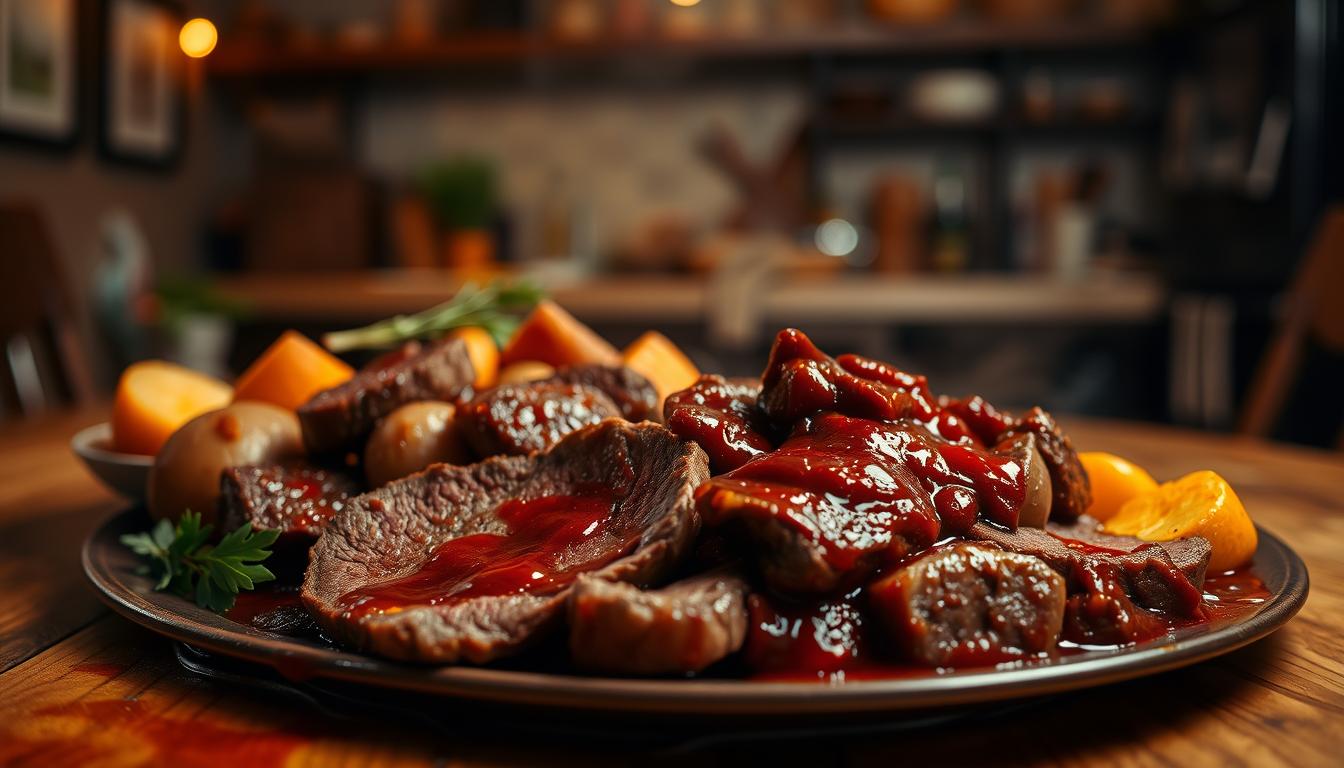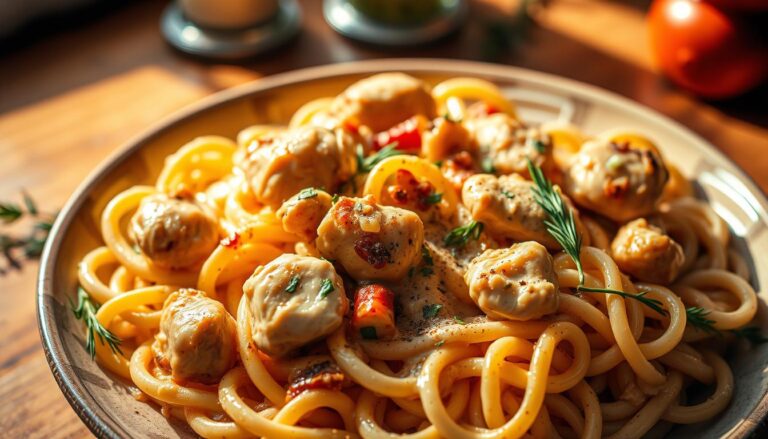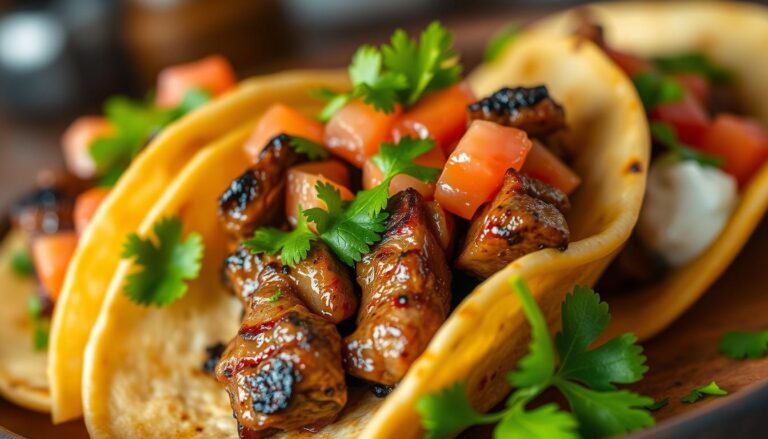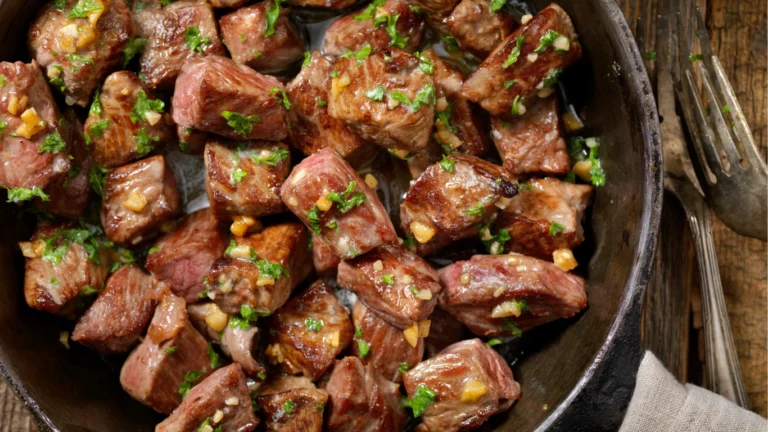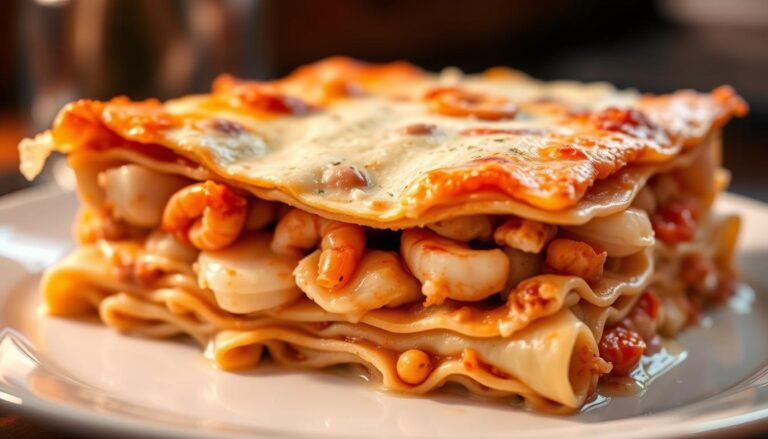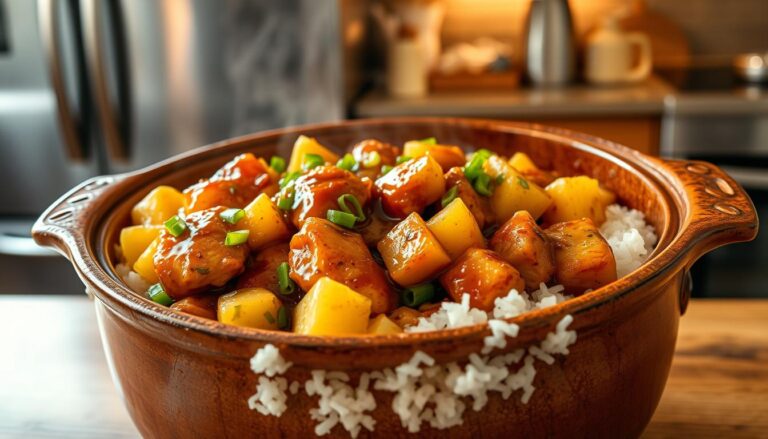Delicious Red Wine Braised Beef Recipe
Table of Contents
Imagine a cold winter evening. You’re craving something that warms your heart and soul. Our braised beef recipe is a classic comfort food. It’s perfect for special occasions or cozy nights in.
This dish is loved by all, with its rich flavors. The best part? It’s easy to make. This lets you relax while it cooks to perfection.
Key Takeaways
- Easy to prepare with minimal supervision
- Perfect for special occasions or cozy nights in
- A classic comfort food dish
- Rich flavors that will leave you wanting more
- Great for busy home cooks
What is Red Wine Braised Beef?
The art of braising beef in red wine is a key part of many cuisines. It brings a depth of flavor that other methods can’t match. This method cooks the beef in red wine over low heat for a long time. This makes the meat tender and full of flavor.
A Brief Overview of the Dish
Red wine braised beef is a classic example of the braising technique. The slow cooking breaks down the meat’s connective tissues. This makes it tender and easy to shred or slice. The red wine adds a rich, fruity taste that goes well with the beef.
The beauty of braising is its simplicity and the little supervision it needs. After the initial prep, the dish cooks on its own. It fills your kitchen with the smell of slow-cooked beef and red wine.
Origin and Cultural Significance
Braising has a long history across cultures, with each having its own version. It’s very popular in European cuisine, where it’s seen as comfort food for family gatherings.
Some key points about braising’s cultural significance include:
- The communal aspect of sharing slow-cooked meals
- The tradition of using locally sourced ingredients
- The versatility of the technique, allowing for various ingredients and flavors
In many cultures, a braised beef dish is more than just food. It’s an event that brings people together. Whether it’s for a special occasion or a simple family dinner, slow-cooking beef in red wine shows the power of food to unite and comfort.
Ingredients You’ll Need
The key to a great red wine braised beef recipe is the quality of its ingredients. To make a dish that’s both tasty and tender, you need to pick the right parts.
Essential Ingredients List
For a classic red wine braised beef, you’ll need these essential ingredients:
- Beef Chuck Roast: This cut is perfect because of its marbling. It makes the meat tender and flavorful when braised.
- Onions: They add a depth of flavor and sweetness.
- Carrots: They help with the flavor and texture.
- Red Wine: A good quality red wine is key. It’s what makes the braising liquid.
- Beef Broth: It boosts the beef flavor and keeps it moist.
- Tomato Paste: Concentrated tomatoes bring a rich, intense flavor.
Optional Additions for Flavor
To make your red wine braised beef even better, try adding these optional ingredients:
- Mushrooms: They add an earthy flavor and meaty texture.
- Bacon: It brings a smoky, savory taste.
- Herbs and Spices: Thyme, rosemary, and bay leaves add aromatic flavors. Black pepper enhances the taste.
By mixing these ingredients carefully, you can make a red wine braised beef dish that’s both satisfying and unforgettable.
Preparing Your Ingredients
The preparation of ingredients is the foundation of a successful red wine braised beef recipe. To ensure that your dish turns out tender and flavorful, you need to choose the right cuts of beef and prepare the accompanying vegetables and aromatics.
Choosing the Right Cuts of Beef
When it comes to braising, the cut of beef you choose is crucial. Beef chuck roast is a popular choice because it’s tender, flavorful, and becomes even more tender with slow cooking. Other good options include short ribs and brisket. Look for cuts with a good amount of marbling, as this will add to the tenderness and flavor of the dish.
Vegetables and Aromatics to Use
In addition to the beef, you’ll need to prepare a variety of vegetables and aromatics to add depth and complexity to your braised beef. Onions, carrots, and celery are classic choices, and can be sautéed in a pan to bring out their natural flavors. You can also add other aromatics like garlic, thyme, and bay leaves to enhance the flavor of the dish.
To prepare your vegetables, simply chop them into bite-sized pieces and sauté them in a pan with some oil until they’re tender and fragrant. This will help to release their natural flavors and add them to the dish.
The Cooking Process
Cooking red wine braised beef is a simple yet detailed process. It brings out the beef’s natural flavors. This dish is great for special events or a cozy dinner.
Step-by-Step Braising Instructions
To begin, brown the beef in a pan over medium-high heat. This step is key as it creates a rich, caramelized crust. Use a large Dutch oven or a heavy pot that can handle high heat.
After browning the beef, remove it and set it aside. Then, add your aromatic vegetables like onions, carrots, and celery to the pot. Cook until they’re soft.
Next, add the red wine and beef broth to the pot. Scrape up any browned bits from the bottom. Return the beef to the pot, cover it, and put it in a preheated oven. The slow cooking will make the beef tender.
Tips for Perfecting Your Technique
To master braising, choose the right cut of beef. Chuck or short ribs are best because they become tender during cooking.
Be patient and let the beef cook slowly. Rushing can make the meat tough and flavorless. Slow cooking blends the flavors, creating a rich red wine sauce.
- Use a heavy pot that distributes heat evenly.
- Don’t skip browning the beef; it’s essential for flavor.
- Let the dish cook slowly to tenderize the beef.
Choosing the Right Red Wine
Red wine is more than just an ingredient. It’s a key to unlocking the rich flavors in your braised beef. The right red wine can make your dish more complex and satisfying.
Best Types of Red Wine for Braising
Not all red wines are good for braising. You need a wine that adds depth and a fruity undertone to your beef. Here are some of the best red wines for braising:
- Cabernet Sauvignon, known for its bold flavors and tannins that complement the richness of beef.
- Merlot, which offers plum and blackberry notes that enhance the beef’s natural flavors.
- Syrah/Shiraz, providing a spicy and robust flavor profile that pairs well with the slow-cooked beef.
How Wine Influences Flavor
The red wine used in braising doesn’t just cook the beef; it becomes part of the sauce. As it cooks down, its tannins and flavors mix with the beef and other ingredients. This creates a rich, layered taste experience.
Here’s a comparison of how different red wines can affect the flavor of your braised beef:
| Red Wine Type | Flavor Profile | Impact on Braised Beef |
|---|---|---|
| Cabernet Sauvignon | Bold, tannic, with dark fruit notes | Adds complexity and depth, pairs well with robust beef flavors. |
| Merlot | Fruity, smooth, with hints of chocolate | Enhances beef’s natural flavors, adds a smooth, velvety texture to the sauce. |
| Syrah/Shiraz | Spicy, robust, with dark fruit and pepper notes | Provides a bold, spicy flavor that complements slow-cooked beef. |
By choosing the right red wine, you can significantly enhance the flavor of your braised beef. This makes it a memorable dish for any occasion.
Enhancing Flavor with Spices
The right mix of spices and herbs can make your braised beef unforgettable. By picking and blending them carefully, you can deepen and enrich the flavor of your dish.
Must-Have Spices for Braised Beef
Some spices are key for braising beef. Thyme, rosemary, and bay leaves are great for boosting the beef’s rich taste. Black pepper and cloves also add warmth and depth.
To make your spices work best, toast them lightly before adding them. This step helps unlock their full flavor.
Creative Herb Variations
While thyme and rosemary are classics, you can try other herbs for new tastes. Adding fresh parsley or fresh sage near the end can bring a fresh, bright note to your dish.
Here’s a table with some herb and spice combos to try with your braised beef:
| Herb/Spice Combination | Flavor Profile |
|---|---|
| Thyme and Rosemary | Classic, savory flavor |
| Bay Leaves and Cloves | Warm, aromatic flavor |
| Parsley and Black Pepper | Fresh, slightly spicy flavor |
Adding the right spices and herbs to your braised beef can take it to the next level. It makes for a memorable meal.
Cooking Tools You’ll Require
The right cooking tools are key to making a tasty Red Wine Braised Beef. You’ll need a few important items to get tender, flavorful results.
Essential Kitchen Tools
A Dutch oven or a heavy-bottomed pot is a must for braising. These pots spread heat evenly and work well on the stovetop and in the oven. You’ll also need:
- A sharp knife for cutting your beef and vegetables
- A cutting board for preparing ingredients
- A measuring cup and spoons for accurate seasoning
- A wooden spoon or spatula for stirring
Optional Gadgets for Better Results
While not necessary, some kitchen gadgets can improve your braising. Think about using:
- A slow cooker for hands-off, long-duration cooking
- An Instant Pot for quicker braising times
- A meat thermometer to ensure your beef is cooked to the perfect tenderness
With these cooking tools and gadgets, you’re ready to make a delicious Red Wine Braised Beef.
Side Dishes to Pair with Braised Beef
Pairing your braised beef with side dishes can make your meal complete. The right sides can bring out the beef’s rich flavors and add variety.
Classic Pairings to Consider
Mashed potatoes are a classic that goes well with braised beef. Their creamy texture and comforting taste match the tender beef perfectly. Roasted vegetables like carrots or Brussels sprouts also make a great choice. They add color and a nice contrast in texture.
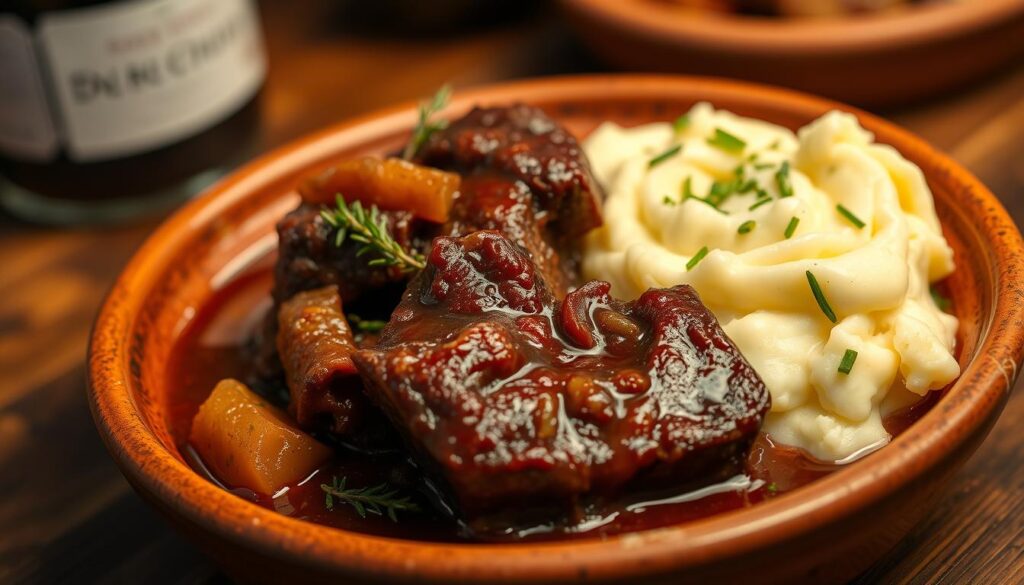
Creative Sides for a Complete Meal
For something different, try sautéed greens like spinach or kale. Cook them quickly with garlic and lemon to keep their color and nutrients. Roasted root vegetables like beets or turnips also offer a sweet and earthy flavor that pairs well with beef.
- Sautéed spinach with garlic
- Roasted root vegetables
- Grilled asparagus with lemon
For a heartier meal, consider egg noodles or polenta with your braised beef. These starches soak up the beef’s juices, making each bite more flavorful. Choose sides that balance the beef’s richness with freshness, texture, and flavor.
Storing and Reheating Leftovers
After cooking a delicious red wine braised beef, you’ll have leftovers. These can be just as tasty the next day. It’s important to store and reheat them right to keep the flavor and texture.
Proper Storage Techniques
For fresh leftovers, store them in an airtight container. This keeps moisture and other flavors away from the beef. You can keep the braised beef in the fridge for 3-4 days. For longer, freeze it.
Tips for Refrigeration:
- Cool the dish to room temperature before refrigerating to prevent bacterial growth.
- Use shallow containers to help the dish cool faster and more evenly.
- Label the containers with the date so you can keep track of how long they’ve been stored.
Reheating Tips for Best Flavor
Reheating your braised beef right is as key as storing it. You can reheat it on the stovetop or in the microwave. For stovetop, use low heat and stir often until it’s warm. In the microwave, cover it to keep moisture in and heat in short bursts, checking until it’s hot.
| Reheating Method | Tips |
|---|---|
| Stovetop | Use low heat, stir occasionally |
| Microwave | Cover the dish, heat in short intervals |
By using these storage and reheating tips, you can enjoy your red wine braised beef for days. You’ll lose little flavor or texture.
Serving Suggestions
How you present your braised beef can make the meal unforgettable. Think about the look you want to achieve and how it will taste. The presentation should match the flavors and textures of the dish.
Plating Ideas for Presentation
For a great look, serve your braised beef over mashed potatoes or with roasted vegetables. You can also try it with egg noodles. They soak up the sauce well.
- Serve over mashed potatoes for a hearty, comforting meal.
- Pair with roasted vegetables for a balanced and nutritious plate.
- Use egg noodles as a base to catch the flavorful sauce.
Garnishes to Wow Your Guests
Adding garnishes can brighten up your dish. Use fresh herbs like parsley or thyme for a fresh touch. A sprinkle of paprika adds smoky flavor.
- Garnish with fresh herbs like parsley or thyme.
- Add a sprinkle of paprika for a smoky depth.
- Use a dollop of sour cream or creme fraiche for a creamy contrast.
Troubleshooting Common Issues
Cooking red wine braised beef can sometimes present challenges, but these can be easily overcome with the right knowledge. Whether you’re dealing with overcooked or undercooked beef, or a dish that’s too salty or too bland, there are solutions to common problems.
Fixing Overcooked or Undercooked Beef
If your beef is overcooked, it may become tough and dry. To salvage it, try slicing it thinly against the grain and serving it with a rich sauce to add moisture. On the other hand, if your beef is undercooked, simply return it to the pot and continue cooking until it reaches your desired level of tenderness.
Adjusting for Taste and Texture
Taste and texture are crucial elements of a successful braised beef dish. If your dish is too salty, you can balance the flavor by adding a splash of vinegar or a bit more red wine. If it’s too bland, try adding more aromatics or spices to enhance the flavor. For texture, ensure that your vegetables are tender but not mushy, and that the beef is fall-apart tender.
To adjust the seasoning, taste your dish regularly as you cook and make adjustments as needed. You can also add a slurry of flour and water to thicken the sauce if it becomes too thin during cooking.
By being aware of these common issues and knowing how to troubleshoot them, you’ll be well on your way to creating a delicious and memorable red wine braised beef dish.
Conclusion: Enjoying Your Red Wine Braised Beef
Now that you’ve learned how to cook Red Wine Braised Beef, it’s time to share it. This dish is great for entertaining, whether it’s a dinner party or a cozy night in.
Making it a Special Occasion
Invite friends over for a feast or share it with neighbors and loved ones. The joy of cooking is in sharing and enjoying the meal with others.
Creating Lasting Memories
Enjoying your Red Wine Braised Beef will make memories with those around you. So, pour a glass of red wine and enjoy a delicious meal together.

